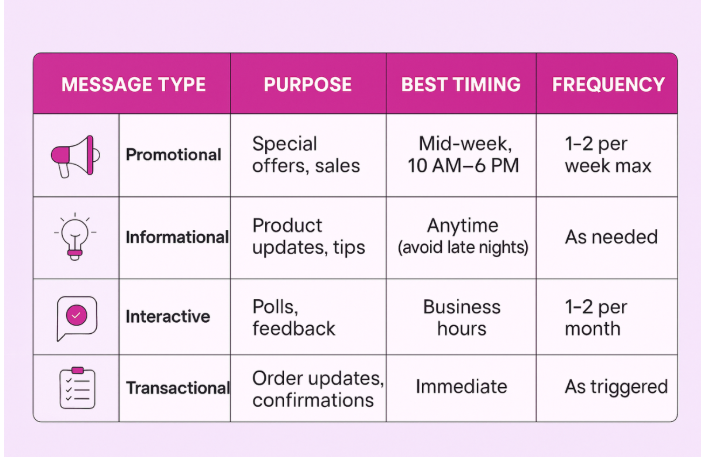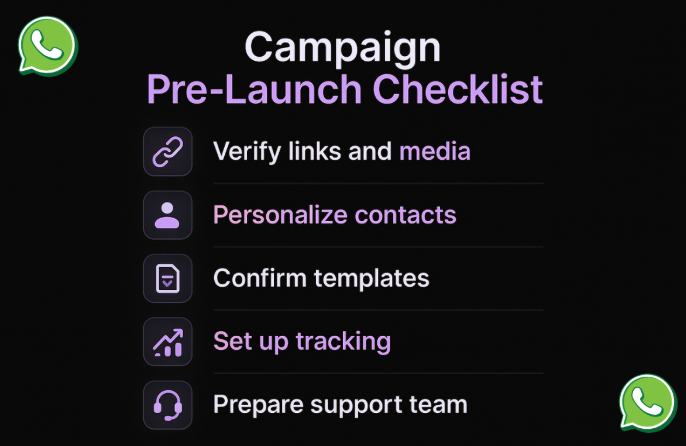
WhatsApp has evolved far beyond casual conversations between friends. It has actually become one of the most powerful channels for businesses to connect with customers.
However, simply sending messages on WhatsApp doesn't guarantee success. The difference between campaigns that fall flat and those that drive meaningful results lies in grasping what a WhatsApp marketing campaign is and how to execute it with precision.
The platform's intimate nature means customers expect personalized, valuable interactions, not spam. This creates both an incredible opportunity and a significant challenge for businesses looking to leverage WhatsApp for growth.
What Is WhatsApp Marketing Campaign and How It Works
A WhatsApp marketing campaign is a permission-based communication strategy where businesses use WhatsApp to send targeted, personalized messages to their audience, often for promotions, updates, customer service, or re-engagement.
But how do WhatsApp marketing campaigns work? These campaigns rely on users opting in, ensuring that outreach happens within a trusted, two-way communication environment.
Unlike traditional channels, WhatsApp operates in a space usually reserved for personal interactions. Messages land directly alongside chats from friends and family, which means your brand must earn its presence through relevance, respect, and clarity.
Step-by-Step Guide: How to Run WhatsApp Campaign Successfully
Running a successful WhatsApp campaign starts with a clear strategy and thoughtful execution. Each step must prioritize user consent, relevance, and timely engagement.
Step 1: Choose Your WhatsApp Business Solution
For businesses serious about running campaigns, the WhatsApp Business app has limitations that make scaling difficult. You'll need access to the WhatsApp Business Platform (formerly WhatsApp Business API), which provides the infrastructure needed for larger-scale operations.
Your options:
- WhatsApp Business App: Free but limited to 256 contacts and basic features
- WhatsApp Business Platform: Advanced features through Business Solution Providers (BSPs)
- Third-party platforms: User-friendly interfaces with additional campaign management tools
The Business Platform offers features that are key for campaigns, including bulk messaging capabilities, automated responses, rich media support, and detailed analytics. Most businesses access these features through BSPs, which provide user-friendly interfaces.
Step 2: Build Your Contact Database Strategically
Your WhatsApp contact list is your most valuable asset, but quality trumps quantity every time. Focus on collecting contacts from people who have demonstrated genuine interest in your business.
Once you have contacts, segment them based on interests, purchase history, demographics, or position in your sales funnel. This segmentation becomes the foundation for personalized campaign messaging that resonates with different audience groups.
Step 3: Plan Your Message Strategy
Successful WhatsApp messages solve problems or provide immediate value. Every message should answer the question: "What's in it for the recipient?" This value-first approach builds trust and keeps people engaged with your brand.

Plan your content calendar around customer needs and business objectives. You can do this, for example, by mixing promotional content with valuable information to maintain engagement without appearing pushy.
Step 4: Create Compelling Message Content
Writing for WhatsApp requires a conversational tone that feels natural and personal. Messages should be concise, clear, and action-oriented.
Use rich media purposefully: Images grab attention and convey information quickly, videos can demonstrate products, and documents work well for detailed information like catalogs or guides.
Step 5: Set Up Automation and Templates
Smart automation improves campaign efficiency without sacrificing the personal touch that makes WhatsApp effective. Wondering how do WhatsApp marketing campaigns work at scale? Well, it’s pretty simple - through strategic automation combined with human oversight.
Create WhatsApp message templates in advance and get them approved through WhatsApp's template system. This prevents delays when you're ready to launch time-sensitive campaigns.
Step 6: Launch and Monitor Your Campaign
Start with a small segment to test your messaging before rolling out to your entire list. This allows you to identify issues and optimize performance before full deployment.
Here goes your one and only launch checklist:

And, an extra piece of advice - Monitor your campaign in real-time during the first few hours after launch to catch any immediate issues or opportunities for quick optimization.
Step 7: Measure and Optimize Performance
Now, let’s take a look at the KPIs that you should track:
- Delivery Rate: Percentage of messages successfully delivered
- Read Rate: Percentage of delivered messages opened
- Response Rate: Percentage of recipients who reply
- Conversion Rate: Percentage who take the desired action
- Unsubscribe Rate: Should stay below 2% for healthy campaigns
Don't get caught up in vanity metrics. A campaign with a lower open rate but higher conversion rate is more valuable than one with perfect delivery but no business results.
Advanced Strategies for Better Results
Now that we have covered the basics, we also wanted to share some extra tips to help you reach the full potential of WhatsApp marketing.
After all, sometimes you do need to move beyond basic broadcasts and tap into strategies that drive engagement, build trust, and convert even faster.
Pro Tip: The 24-Hour Window Strategy

When a customer initiates contact or responds to your message, you have 24 hours to send follow-up messages without requiring a new template approval.
Our advice is to use WhatsApp's 24-hour messaging window strategically and differently than others, and here’s how.
Use this window to create micro-conversation sequences that guide customers through your sales process. Start with a helpful response to their initial query, then follow up with related information, social proof, or gentle calls-to-action within that 24-hour period.
Integration with Your Marketing Ecosystem
WhatsApp campaigns work best when integrated with your broader marketing strategy. Connect WhatsApp with your CRM to track customer interactions across all touchpoints. This integrated approach allows you to create cohesive customer experiences where WhatsApp supports and amplifies your other marketing campaign efforts.
For example, you might use email to announce a new product, then follow up with WhatsApp for personalized recommendations or exclusive offers based on customer browsing behavior or purchase history.
Compliance and Best Practices
WhatsApp has strict policies about business messaging, and violations can result in account restrictions or bans. Following this WhatsApp campaigns guide means prioritizing compliance from day one.
- Obtain explicit opt-in consent for all contacts before messaging
- Provide clear unsubscribe options in every promotional message
- Respect messaging frequency limits and customer preferences
- Adhere to content policies and avoid restricted categories
- Maintain accurate records of consent and opt-out requests
Always respect unsubscribe requests immediately and keep your messaging frequency reasonable. Even if customers haven't unsubscribed, bombarding them with messages will damage your relationship and potentially lead to reports that could affect your account standing.
Transform Your Customer Communication Today
Learning how to run WhatsApp campaign successfully requires combining strategic planning with authentic relationship-building. The step-by-step approach outlined in this WhatsApp campaign guide provides the foundation for creating meaningful connections that drive both customer satisfaction and business growth.
The businesses seeing the biggest returns understand that WhatsApp marketing campaigns work best when they feel like helpful conversations rather than traditional advertising. They prioritize value over volume, personalization over automation, and relationships over transactions.
Whether you're just getting started or looking to scale, TopMessage helps you execute WhatsApp marketing campaigns with precision and ease, so if you need any help, don’t hesitate to reach out!
FAQs
How often should I send WhatsApp campaign messages?
Quality should always trump quantity. Most successful businesses send 1-2 promotional messages per week, maximum, with additional transactional or customer service messages as needed. Monitor your unsubscribe rates and customer feedback to find the right balance.
Can I import my email marketing list to WhatsApp?
No, you cannot simply import existing email lists to WhatsApp. Each contact must explicitly opt in to receive WhatsApp messages from your business. You can invite email subscribers to join your WhatsApp list, but they must take a separate action to consent.
What's the difference between the WhatsApp Business app and the WhatsApp Business Platform?
The WhatsApp Business app is free but limited to basic features and small-scale operations. The WhatsApp Business Platform offers advanced features like bulk messaging, automation, and detailed analytics, but requires working with approved solution providers.
How do I measure ROI from WhatsApp campaigns?
Track conversions using unique promo codes, trackable links, or by asking customers how they heard about offers. While WhatsApp provides delivery and read receipts, connecting these metrics to actual business results requires integrating with your sales and analytics systems.
What types of content work best for WhatsApp marketing campaigns?
Focus on valuable, actionable content that solves customer problems. Exclusive offers, product updates, helpful tips, and personalized recommendations typically perform well. Rich media like images and videos can boost engagement when used strategically.